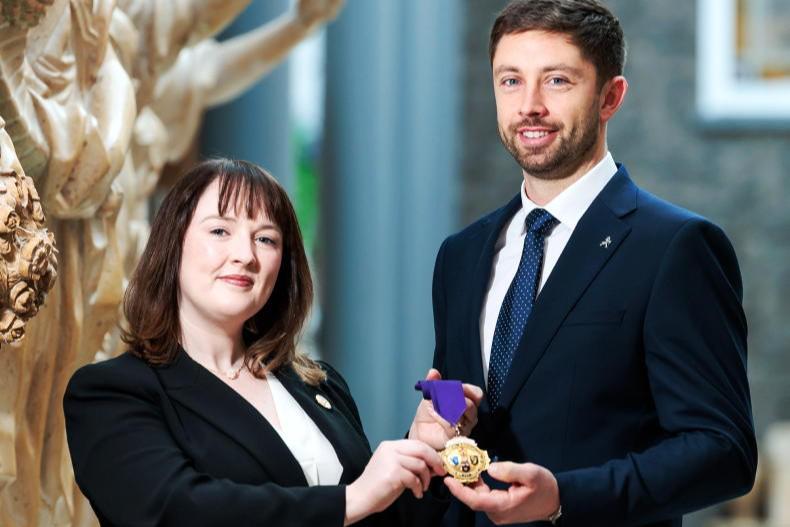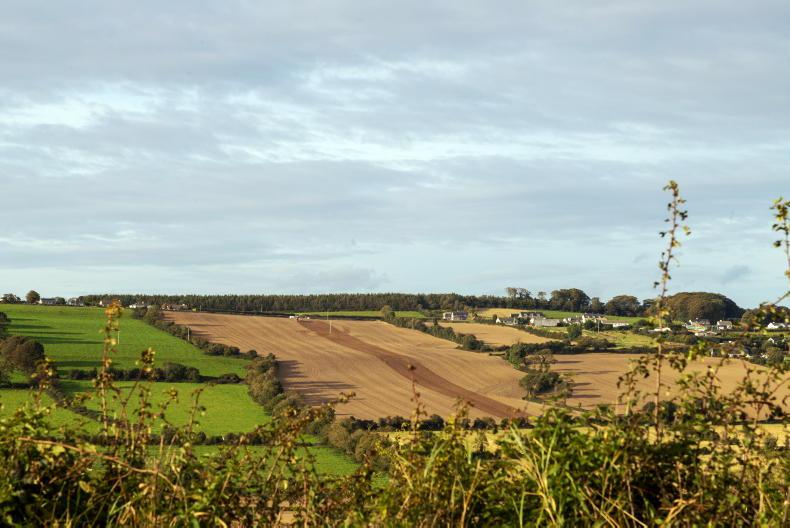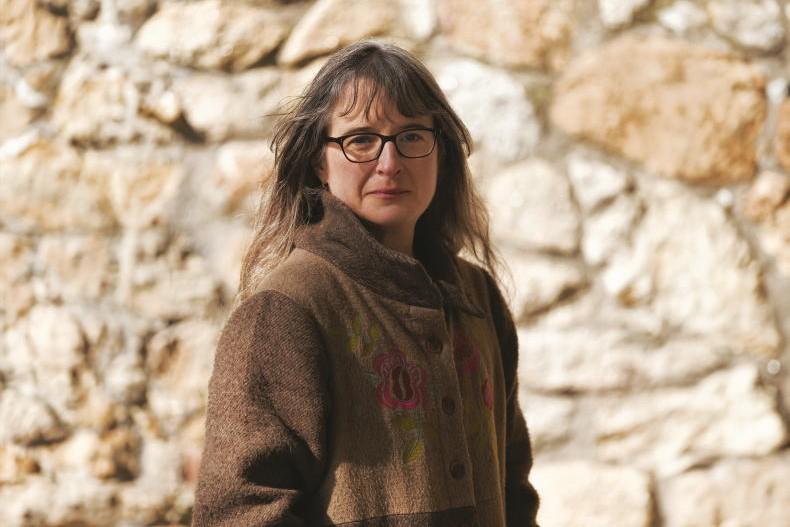I’m originally from Rosmuc, out in Connemara. It’s along the coast, about 10 miles from Maam Cross. I have very happy memories growing up there. You were running free compared to today – now kids can’t even go outside the door. The neighbours, you’d be just calling into them. I used to go down with them, helping with the seaweed out on their boats, bringing it in and spreading it on the fields. I’d go to the bog with them too.
There was a great sense of community and it’s still there. They’ve held on to it and they’ve held on to the language.
Nowadays, I speak Irish as often as I can. Even if someone has bad Irish, I’d speak away to them.
A good way of doing it is bilingually, stick in the words that you know. Gradually, the words will come back to you
People don’t give other people trying to speak the language time. Correcting people, that’s one of the worst things you can do. You feel as if you’ve been spoken to. It’s all about confidence.
There’s an old saying: “Is fearr Gaeilge briste ná Béarla cliste.” It means: “Broken Irish is better than clever English.”
A good way of doing it is bilingually, stick in the words that you know. Gradually, the words will come back to you and you’d have more Irish than English. You do it slowly. You don’t put any pressure on yourself.
Observation
I live in Galway city now. It is a great place to live. It’s a young people’s city. It’s big enough and small enough. But it was in Rosmuc I learned to build boats, anyway.
All the families in Rosmuc had a bit of land, they had a bit of bog, and they had a bit of shore for cutting seaweed and that, so there were boats there all the time coming and going.
The man I used to help with the boat building was a man by the name of Colm Walsh. Colm was one of the very good builders there of Galway Hookers.
My father built a boat as well, but his boat would be different. It was a lake boat. I’m not interested in lake boats
Now, basically it’s very hard to help anybody building a boat because it’s fairly complex, but observation was my thing. Just watching him and the way he built it and how he built it.
My father built a boat as well, but his boat would be different. It was a lake boat. I’m not interested in lake boats. Colm was building currachs and hookers.
In today’s terms the currach would be a Jeep or a work horse because you could pull her up on the shore any place. She’s easy to patch up and she’s a very efficient little boat.
There’d be small differences in currachs in different parts of the country.
Full circle
You have to go away to really appreciate a place. I was in aerial photography for a good while, but I always knew I’d come back building boats.
I was in Clare. I was in Dublin. I was in London. Then I came back to Galway. I’m 68 now and I started back into the traditional boat building about 10 years ago.
I’m not doing a whole pile of building for other people right now
The first one I built was a currach for myself. Then I built a currach for the Sea Scouts. They were going to use it as a training boat. Then I built another one for a movie/semi-documentary that was being made.
People also asked me to repair their boats or build one. That’s the way it went, you know. I had a little workshop here.
I’m just building another boat for myself at the minute. I’m not doing a whole pile of building for other people right now.
It’s not something that you do every day. I do it the old way in winter time. I could be working until two o’clock in the morning and the next few days I wouldn’t work at all. It depends. It’s a process that you can’t rush, really.
Waterways
Since I came to Galway city I’ve been very interested in its waterways. All the industries in Galway were water run, the mills and all that.
They started bringing the Corrib down sideways and cutting their own little rivers and putting in the wheels. The wheels then turned the factories.
I did tour guiding for a while. The reason I started was, when I’d be repairing boats down in the Claddagh, which is where all the boats would be, people were just taking photographs and asking me questions. That’s how it started.
Last year then I started up the Galway Maritime Museum. We had an exhibition in St Nicholas’s Church, Lynch’s Castle and now we have it in Galway Crystal.
Our next exhibition is going to be replica model boats. We have Christopher Columbus’s ship as he visited Galway. We have a famine ship and a passenger ship from Galway. We have Tom Crean and Ernest Shackleton’s boat, Endurance.

Model of the boat Endurance.
They’re museum standard. They’re seven foot long and the sails are seven foot high.
I’d like to put them on display along the Wild Atlantic Way, somewhere between Kerry and Galway. So I’m looking for a farmer with an on-farm business or an open farm who might want to house them. Watch this space.
Read more
Podcast: Gift of the gab with Katie Jane Cronin
My Country Living: a twist on tradition
I’m originally from Rosmuc, out in Connemara. It’s along the coast, about 10 miles from Maam Cross. I have very happy memories growing up there. You were running free compared to today – now kids can’t even go outside the door. The neighbours, you’d be just calling into them. I used to go down with them, helping with the seaweed out on their boats, bringing it in and spreading it on the fields. I’d go to the bog with them too.
There was a great sense of community and it’s still there. They’ve held on to it and they’ve held on to the language.
Nowadays, I speak Irish as often as I can. Even if someone has bad Irish, I’d speak away to them.
A good way of doing it is bilingually, stick in the words that you know. Gradually, the words will come back to you
People don’t give other people trying to speak the language time. Correcting people, that’s one of the worst things you can do. You feel as if you’ve been spoken to. It’s all about confidence.
There’s an old saying: “Is fearr Gaeilge briste ná Béarla cliste.” It means: “Broken Irish is better than clever English.”
A good way of doing it is bilingually, stick in the words that you know. Gradually, the words will come back to you and you’d have more Irish than English. You do it slowly. You don’t put any pressure on yourself.
Observation
I live in Galway city now. It is a great place to live. It’s a young people’s city. It’s big enough and small enough. But it was in Rosmuc I learned to build boats, anyway.
All the families in Rosmuc had a bit of land, they had a bit of bog, and they had a bit of shore for cutting seaweed and that, so there were boats there all the time coming and going.
The man I used to help with the boat building was a man by the name of Colm Walsh. Colm was one of the very good builders there of Galway Hookers.
My father built a boat as well, but his boat would be different. It was a lake boat. I’m not interested in lake boats
Now, basically it’s very hard to help anybody building a boat because it’s fairly complex, but observation was my thing. Just watching him and the way he built it and how he built it.
My father built a boat as well, but his boat would be different. It was a lake boat. I’m not interested in lake boats. Colm was building currachs and hookers.
In today’s terms the currach would be a Jeep or a work horse because you could pull her up on the shore any place. She’s easy to patch up and she’s a very efficient little boat.
There’d be small differences in currachs in different parts of the country.
Full circle
You have to go away to really appreciate a place. I was in aerial photography for a good while, but I always knew I’d come back building boats.
I was in Clare. I was in Dublin. I was in London. Then I came back to Galway. I’m 68 now and I started back into the traditional boat building about 10 years ago.
I’m not doing a whole pile of building for other people right now
The first one I built was a currach for myself. Then I built a currach for the Sea Scouts. They were going to use it as a training boat. Then I built another one for a movie/semi-documentary that was being made.
People also asked me to repair their boats or build one. That’s the way it went, you know. I had a little workshop here.
I’m just building another boat for myself at the minute. I’m not doing a whole pile of building for other people right now.
It’s not something that you do every day. I do it the old way in winter time. I could be working until two o’clock in the morning and the next few days I wouldn’t work at all. It depends. It’s a process that you can’t rush, really.
Waterways
Since I came to Galway city I’ve been very interested in its waterways. All the industries in Galway were water run, the mills and all that.
They started bringing the Corrib down sideways and cutting their own little rivers and putting in the wheels. The wheels then turned the factories.
I did tour guiding for a while. The reason I started was, when I’d be repairing boats down in the Claddagh, which is where all the boats would be, people were just taking photographs and asking me questions. That’s how it started.
Last year then I started up the Galway Maritime Museum. We had an exhibition in St Nicholas’s Church, Lynch’s Castle and now we have it in Galway Crystal.
Our next exhibition is going to be replica model boats. We have Christopher Columbus’s ship as he visited Galway. We have a famine ship and a passenger ship from Galway. We have Tom Crean and Ernest Shackleton’s boat, Endurance.

Model of the boat Endurance.
They’re museum standard. They’re seven foot long and the sails are seven foot high.
I’d like to put them on display along the Wild Atlantic Way, somewhere between Kerry and Galway. So I’m looking for a farmer with an on-farm business or an open farm who might want to house them. Watch this space.
Read more
Podcast: Gift of the gab with Katie Jane Cronin
My Country Living: a twist on tradition










SHARING OPTIONS